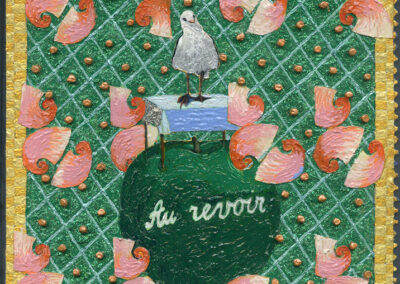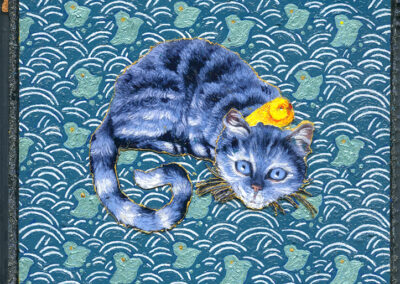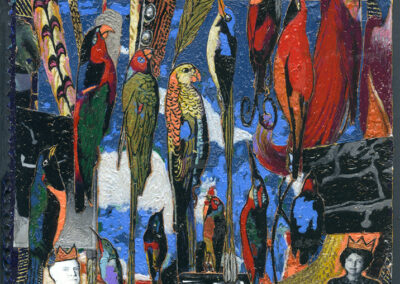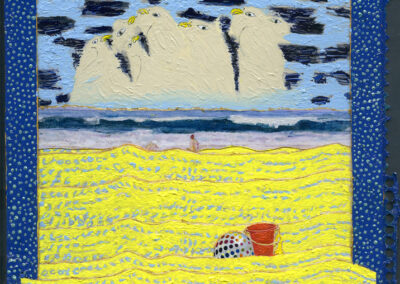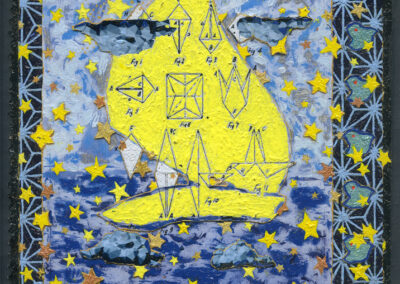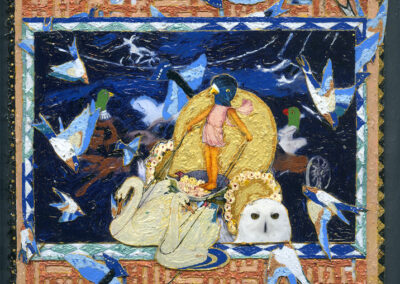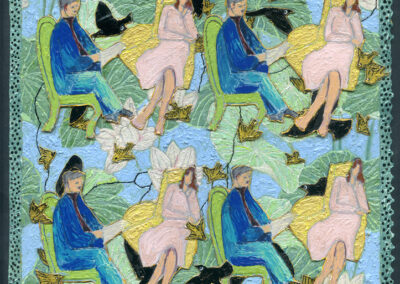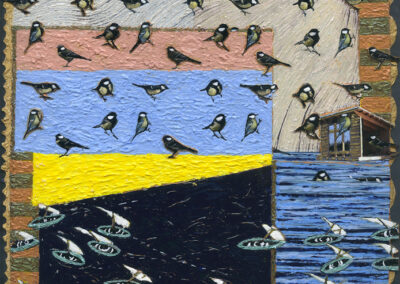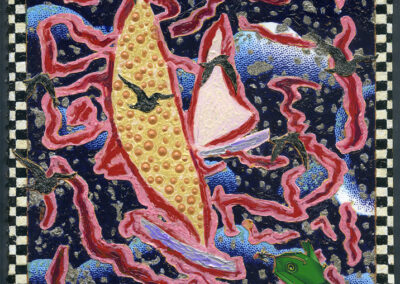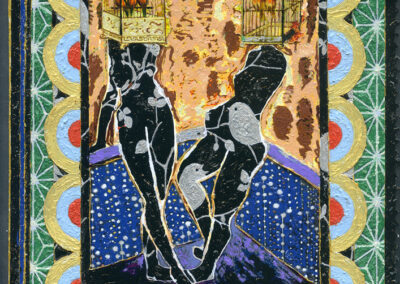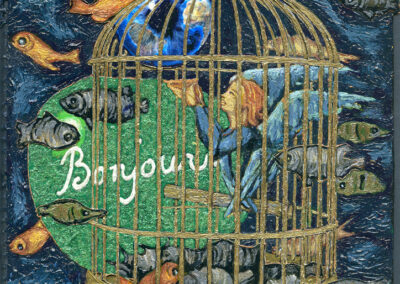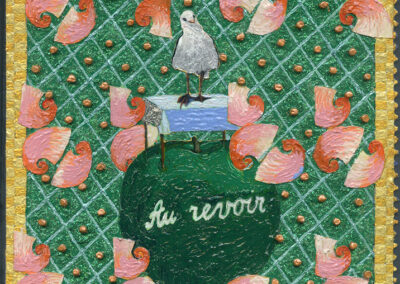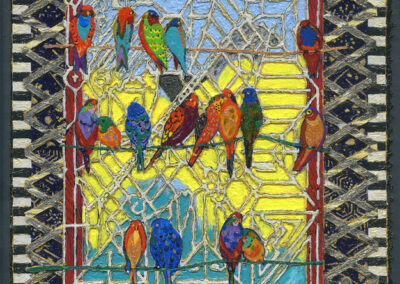“pull quote”
attribution
This series is built upon a catalog of a Milton Avery Exhibition held at the Grace Borgenicht Gallery, 724 Fifth Ave., NYC 10019 with a forward by Sally M. Avery (who was also a painter with a style similar to that of her husband), November. 16, 1983. This exhibition consisted of 12 oil paintings.
The cover
I added a layer over the original cover image that consisted of the words:
‘Milton Avery’ on a dark turquoise background. The birdcage was culled from the internet. I teased it apart in Photoshop so I could place objects inside it. The small winged creature perched on the swing is ‘stolen’ from a small panel that is a part of the Samuel H. Kress collection bequeathed to the National Gallery. It is Crucifixion by an Italian 14th Century painter na ed Bernardo Daddi. The panel was completed probably around 1348.
The panel is poplar chosen probably because of its close smooth grain. Framed it measures 15 3/4″ x 11″. The dark undersea background is half a painting, doubled, of the undersea portion of a painting called “Nereid”, by an artist called Naoto Hattori. It is acrylic on panel. The painting itself is tiny, measuring 3.5″ x 3.5″, but the frame measures 8″ x 8″. This painting, according to the Corey Halford Gallery entry, was included in their exhibition called “Beneath the Waves”, which took place from December 17, 2016 till January 14, 2017. The enormous Granny Smith apple was lifted from a painting called “Au Revoir”, by guess who, Rene Magritte, the Belgian painter who lived from November 21, 1898 till August 1967.
Forbes Magazine by Craig Silver, who is a writer involved in arts and media in New York as a participant and observer, notes:
“No, a work of art didn’t help ignite the personal computing revolution. But a painting by a Belgian artist Rene Magritte. . . . did help inspire the name Apple Computer. And it did so in a roundabout way that goes through Beatle Paul McCartney.”
In Groovy Bob an oral biography of swinging-sixties London Art Dealer, Robert Fraser, the apple-cheeked Beatle (Paul McCartney) relates, “One day he brought this painting to my house, . . . It just had written across it ‘Au revoir,’ on this beautiful green apple.”
Back of Front Cover
This blue cat head (and his body) has been a good friend for many years–since 1999 when I found him in a book called The Art of Alice in Wonderland, by Lovett Stoffel (1998, The Wonderland Press, NYC). The entire blue puss is to be found on page 35.
Blue kitty welcomes you to my scrawls and meanderings about Linking Art and Life (another of my handmade image books)–its images, their sources and thoughts about them.
I have also used blue kitty’s head superimposed on my six year old body as my ID image on my Facebook account.
The background, which contains a repeat pattern of blue birds, is a found print I ordered from a group called Mulberry papers.
Tucked in back of blue cat’s head is a fearless canary reminiscent of Paul Klee’s inclusion of a bird above a cat’s head in his painting called “Cat and Bird”, 1928, which is to be found as part of MOMA’s permanent collection. Klee said that having a cat around the house lent a sense of order.
PAGE 1: Sally and Milton
This page is built around a photograph of Sally Michel Avery and Milton
Avery is their studio abode. Behind them are two paintings hanging on their walls. I assume they are his rather than his hers. I gave each of them crowns courtesy of Jean-Michel Basquiat. After all, don’t Sally and Jean-Michel share a name? Surely, an odd coincidence. I discovered this only when I was adding to this log. In the background I placed Sally Avery’s 1979 painting, “Surf Watchers” (oil on canvasboard, 14″ x 18″). I thought it was only fair to have one of her paintings in the page as well. The numbered exotic bird layer is taken from an altered photograph I took while we were travelling in Jerusalem in 2013. The birds were framed under glass in a restaurant in the Ben Yehuda market area (I believe). In the market itself were untold treasures–beautiful fabrics, garments and small boxes inlaid with Mother-of-Pearl–not to mention rows and rows of marvelously colored candies along with enormous glistening apricots! This framed work included many numbered birds. Along with bottom of the work was printed a legend with each bird’s name in French. One can only wonder why in French. . .This image was worked on during the Trump US Government shut-down of January, 2019–the longest in our history and helped allay or at least assuage my anxiety.
PAGE 2: "Onrushing Wave"
1958, oil on canvas, 54″ x 72″
I thought the sky shapes reminded me of birds, so I sort of enhanced them.
I detached the speckled bottom layer and repeated it three more times below the original section. I then inserted a horizontal section of ocean and two figures from Pierre Bonnard’s “Beach” painting of 1922. Also, I found a beach ball and beach ball from the internet and added them as well. Don’t we all need sand toys when lazing on the beach?
PAGE 3: "Sail"
1958, oil on canvas, 72″ x 50″
The lines on top of the white sailboat are diagrams of how you make an origami crane. The rocky clouds drifted into my ken from a website with a whole bunch of numbers and the odd letter or two, ripe for the picking. I like the idea that they are ironic in that clouds are supposed to wispy and non-material–and these are DEFINITELY not! The background pattern is from an origami patterned paper, and the repeated stylized bluebirds are from the Twitter logo. The gold stars from an image labeled: handdrawn-stars-gold-foil-vector-illustration_ and a whole bunch of numbers.
PAGE 4: "Sand Dunes and Yellow Sky"
1959, oil on canvas, 66″ x 50″
Oboy, did I change that one!! First I added silver lattice work border that I’d collected in one of my image files long ago. Then, there are the parakeets on what look like long green branches. These were culled from the net, the images being labeled with a string of numbers, letters, both capital and lower case, along with the odd symbol. The dark blue border with gold figures is a blue and gold yuzen origami paper. Yuzon or chiyogami papers are papers with brilliant color patterns with gold metallic overlays silk-screened by hand onto kozo paper. Sometimes, I can find a version of Avery’s paintings in color on the interneet, but not this time.
PAGE 5: "The Chariot Race 1933
oil on canvas, 48″ x 72″
The tile border of triangular white and blue tiles is from Zillij, the Art of Moroccan Ceramics, Jahn Hedgecoe & Salma Samar Damluji, p.247. The photo of blue and white tiles, squares and borders is of a close-up of a marble floor in the museum in znaqi. the znaqi are filled in with mharrfah al mrabba’ wal qatib (cut-up tiles in squares and lines). This was taken in the Dar al Batha Museum in Fez, Morocco.
PAGE 5: "The Chariot Race 1933
oil on canvas, 48″ x 72″
The tile border of triangular white and blue tiles is from Zillij, the Art of Moroccan Ceramics, Jahn Hedgecoe & Salma Samar Damluji, p.247. The photo of blue and white tiles, squares and borders is of a close-up of a marble floor in the museum in znaqi. the znaqi are filled in with mharrfah al mrabba’ wal qatib (cut-up tiles in squares and lines). This was taken in the Dar al Batha Museum in Fez, Morocco.
PAGE 6: "Young Couple (Husband and Wife)"
1963, oil on canvas, 50″ x 68″
The black lines are A Little Princess’ book cover as are the golden birds flitting around throughout. The two figures–the one on the left apparently drawing the one on the right (with no shoes on) are repeated three times for a total of a symmetrical four. The lotus wallpaper is from a group called Stick Wallpaper Room Mates. I guess you just stick it up on a wall without the need for wallpaper paste.
PAGE 7: "Boathouse By the Sea"
1959, oil on canvas, 72″ x 60″.
The thick stripes found in the upper right hand corner and lower left were culled from a lithograph by Kathryn Polk. I am unable to locate the exact title. It is of a woman’s head upon a striped background. Somehow the stripes got to be painted a different color. The upper section of the page is taken from another lithograph of hers which I think is entitled “Non Indigenous Woman”. .. . . The boathouse is NOT part of the original painting even though it is called “Boathouse by the Sea” so I thought I would add one. Why not? The sailboats are taken from a painting by Francesco Clemente. I culled the image from once of his paintings called “Midnight Sun” II, 1982, oil on canvas, 79″ x 98 1/2″, Tate Gallery Collection. The small circle with an arrow was taken from a photograph I took in a parking garage near the movie that we used to go to (before Covid). It was on the floor–and I have no idea why it was put there.
PAGE 8: "Sandspit with Gulls"
1958, 66″ x 50″, oil on canvas.
The birds and the cape are stolen from “The Giantess” by Leonora Carrington, c.1950, 46″ x 27″, oil on canvas. I also added an element from Sally Avery, “Tightrope Walker, 1982. Can’t help but wonder why Milton got all the credit so that virtually none was left over for Sally. It’s uncanny how similar their work was, I think. Then there is the odd-looking glass vial taken from a work by Marcel Duchamp called “50cc of Paris on Pink”, 1986. I guess that object was supposed to smell like Paris. I wonder what Paris smelled like in 1986, and I wonder if it smells differently today. There’s always climate change. Concerning the Purple spheres-collection_1010-475: I culled this purple sphere from the net. It is divided into triangles. I was able to kind of make it more dimensional using a special tool–a handle with a sphere on the end. I believe there would be more of a raised quality to the thing had the paper I used been of lighter weight. The extra birds have migrated from another Milton Avery painting called, “Flight”, 1950, 25″ x 36″, oil on canvas. I got the bells off the net. They are inspired by the bells on the hem of the raiment worn by the kohan gadol, the high priest on Yom Kippur, the most profound holiday on the Hebrew calendar, a day of fasting and atonement.
(Josephus, Antiquities of the Jews, Chapter 7, paragraph 4. Also Exodus 28:1-43, 39:1-31.)
PAGE 9: "Sails in Sunset Sea"
1960, 52 x 52″, oil on canvas.
The background is a patterned origami paper. A checkered border is always fun. The flying sea birds were netted from the net, and the dimensional dots on the larger sail were created by dipping the end of a dentist’s tool into a jar of thick liquid paint. I tried split peas, but somehow they didn’t work. The sails and snaky red/pink strokes were cut from the original, and the frog representation is taken from a diagram of how to construct an origami frog. This is one part of the diagram. I believe he is snagging an insect of some sort with his darting tongue. The ‘snowflakes’ are a part of the background origami design that I painted with a fine stainless steel paint that is rather glittery when dry. It is a special color (I think) put out by Golden who makes really yummy acrylic jar paints.
PAGE 10: "Two Figures
1960, 72″ x 62″, oil on canvas.
The repeated painted half circles are borrowed from images by Hilma Af Klint, The Swan, No. 16, Group IX/S, 1915 the Temple. Hilma Af Klint was a mystic and painter who lived in Sweden between 1862 and 1944. The background is an origami pattern paper sheet. Bird cages with birds instead of heads came from a sheet of bird cage images in my collection. The blue background layer with white and colored dots connected with fine white lines is from a painting by Barbara Takenaga called Little Green/Blue 20″ 6″ x 6″. The borders come from Mohammad Yusof’s “Bird and Flower.” 17th Cen. Iran.
PAGE 11: "Birds over Sea", 1957
The background, gathered from the internet, is a border of water. It is referred to as “800px_COLOURBOX5560094.jpg. I repeated the white gulls that were already a part of Avery’s painting several times. The blue, bubbly background was also grabbed from the internet’s trove of water imagery.
PAGE 12: "Two Women" (Milton Avery), 1959
oil on canvas 50″ x 68″.
The woman is from Avery’s “Two Women”. The bird head was culled from
the internet. Sadly, the second woman simply disappeared. Images: Inside Information, Imaging the Human Body, William A. Ewing. The Spleen, p. 66. ” . . . in section, showing the fine network of fibers known as trabeculae which form a framework within which the functions of this organ take place. The spleen is part of the lymphatic system
and is involved in processing which blood cells. It also regulates the number of red blood cells. It also regulates the number of red blood cells in circulation in the bloodstream. Coloured scanning electron micrograph. Magnification x 9880. Alfred Pasieka, p.67. A Fireside Book, Simon & Schuster Editions, 1966 by Thames and Hudson, London.
INSIDE BACK COVER
The circle in the center is a section of a bird’s eye view of a garden, I think.It comes from a site called Fam.journal1 ( by Esben Rasmussen. Just above his name there appears a bit of the Danish flag inside a circle of sky blue. On the site we saw parts of dukehaus (Model H.C.M. It is very elegant with candelabra on the table and a chandelier to hang. After bits diagrammed of other rooms, I find a page of kids and several animals along with some poisonous but colorful mushrooms. This site is a true treasure trove of images one is tempted to eat rather than steal from . . .
The triangular eye red and pink swirling element comes from a very odd Medieval image depicting I-am-not-sure-what. Two wrists with hands dropping things extend from below the swirling circles of scarlet smoke. Underneath stretches a very long scaleless fish (a white whale?) with a red-robed figure emerging from the creature’s mouth. The hand on our right is dropping gold coins into the eager hand of Jonah (?). The hand on our left is dropping what look like dark red spheres past the tale of the gigantic creature. Below resides a tree with a lake below from which some birds are drinking. On our left, beside the tree whose top is but an inch or so above the level of the red-clad kneeling figure more dark balls fall. Behind her is another, larger woman. Both figures appear to be praying. Could it be part of a psalter? The gray wave, repeated in the four directions, is from an Avery painting called “Jagged Wave”, 1954, oil on canvas, 30 x 54″. The table upon which the eye enclosed by a triangular shape rests, along with the watery background is lifted from a Rene Magritte painting called “Fine Realities” or “Beautiful Truth”, 1964, oil on canvas. I have surfed the net in vain to discover the actual size of this work, but if I want a reproduction of it, there are sites that advertise their willingness to provide me with one–in any size I want! A true embarrassment of riches, yes? The dark blue background with its golden arrows is from an old manuscript page whose origin I fear will remain a deep dark mystery. To me it looks like a reproduction of an ancient Tantric image depicting the nature of energy.
So here we have in this inside back cover image an attempt perhaps to impose order on an otherwise chaotic universe . . . perhaps . . .
BACK COVER
I constructed the background page consisting of pale green diagonals forming diamond shapes on top of a Kelly green background. The orange to pink shapes were taken from the designs that Bennett Bean paints on his pots/vessels. He makes gorgeous vessels whose insides are covered with either gold or silver leaf. The center consists of a section of another Magritte painting called “Fine Realities”. I disengaged the table and apple from the watery background and added the words, “au revoir” from yet another Magritte painting called “Au Revoir” from 1966. I simply transferred the words from that apple to the apple that the table is resting on (with its resident bird. It’s the same apple I used (altered to say Bon Jour that I used for the cover. I used painted tiny clear beads to form part of the background design and used glitter glue as well.

